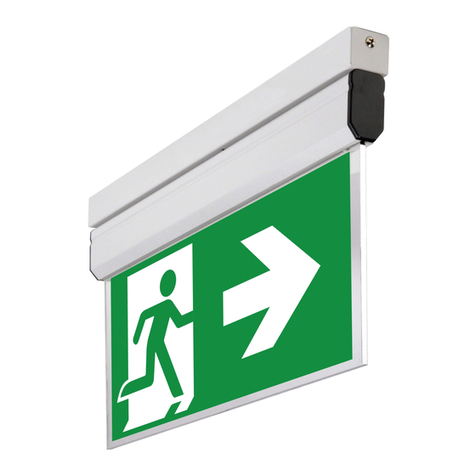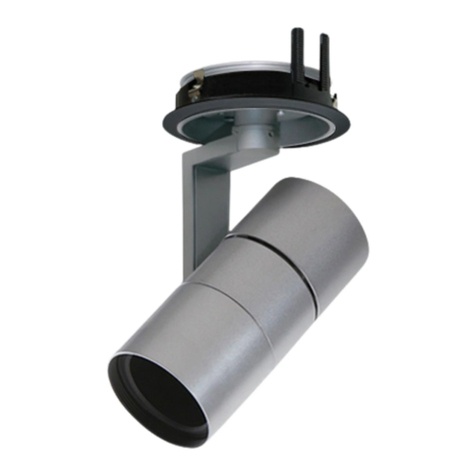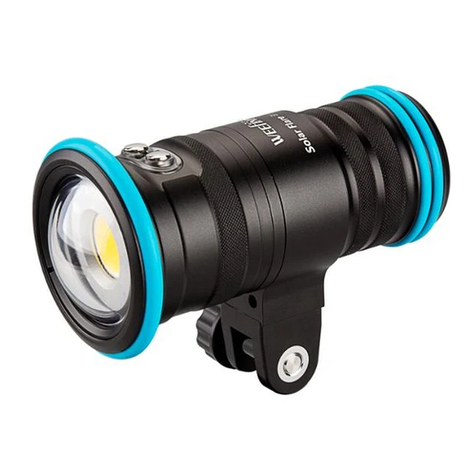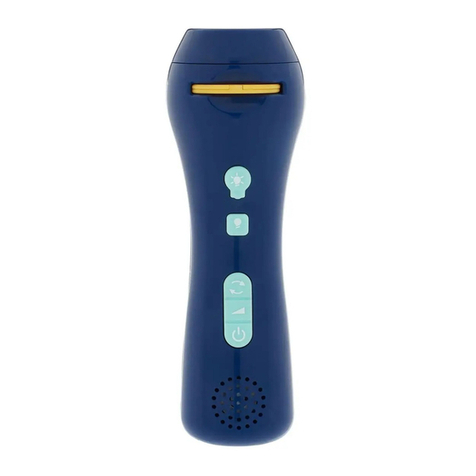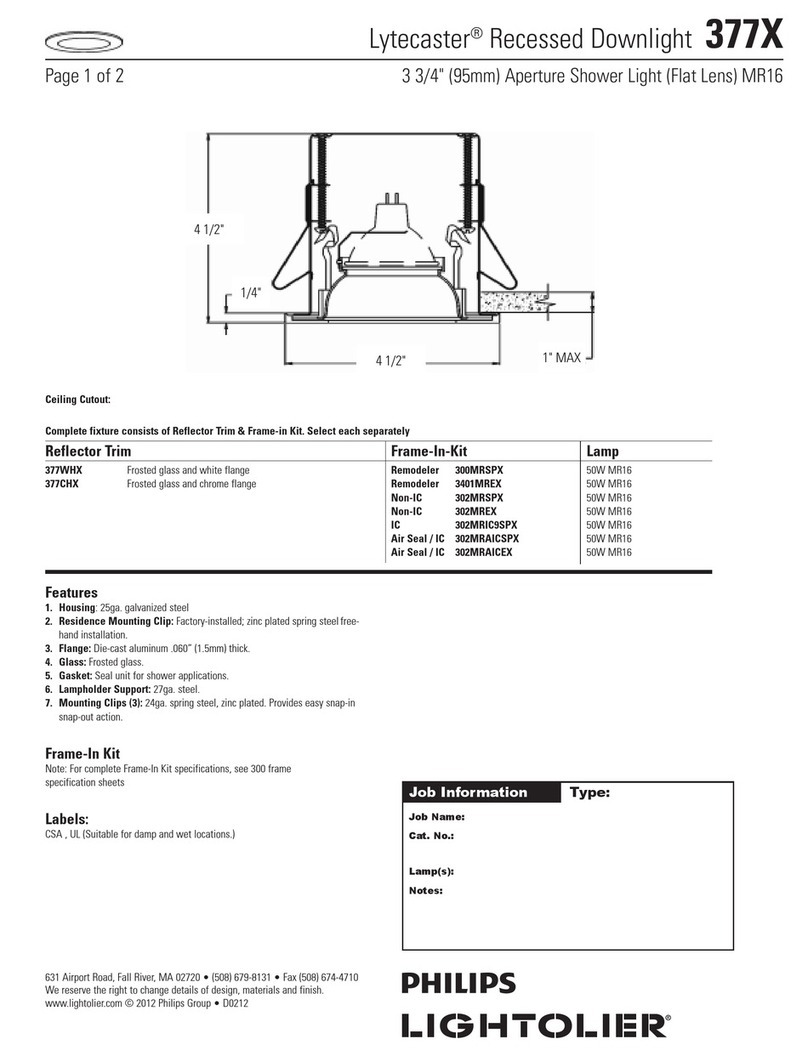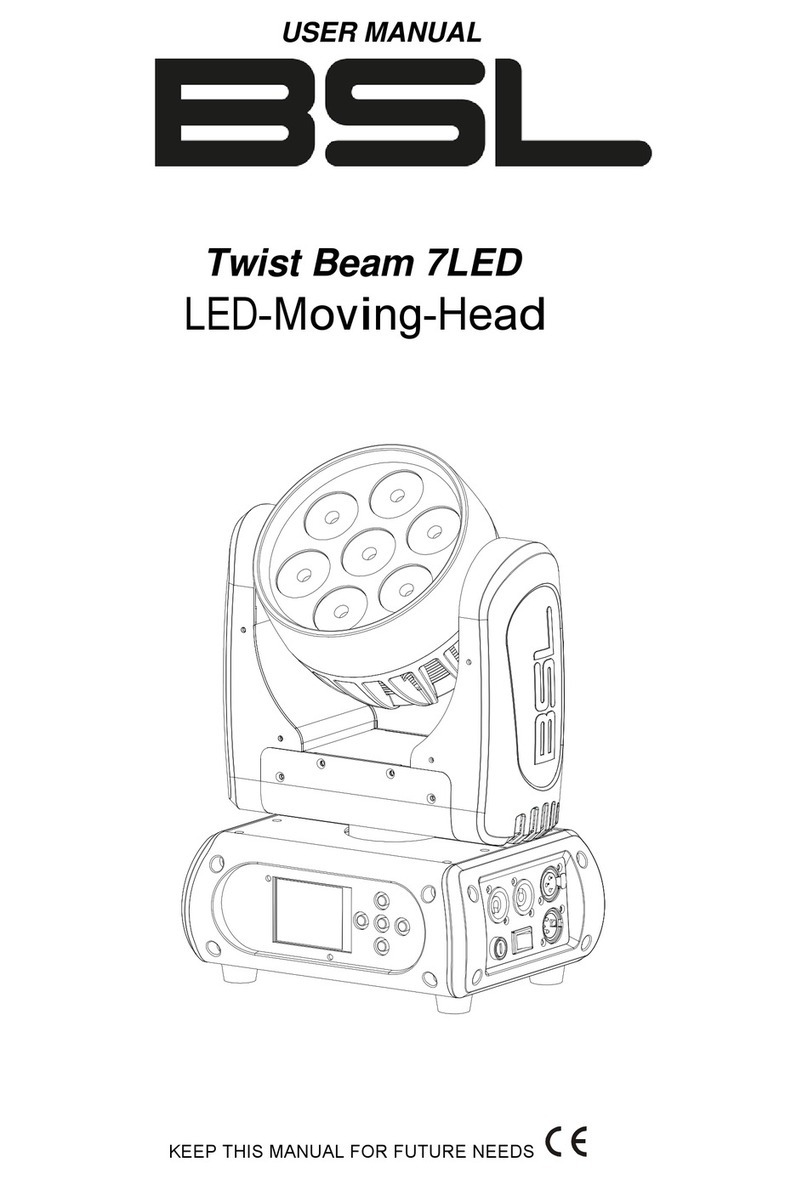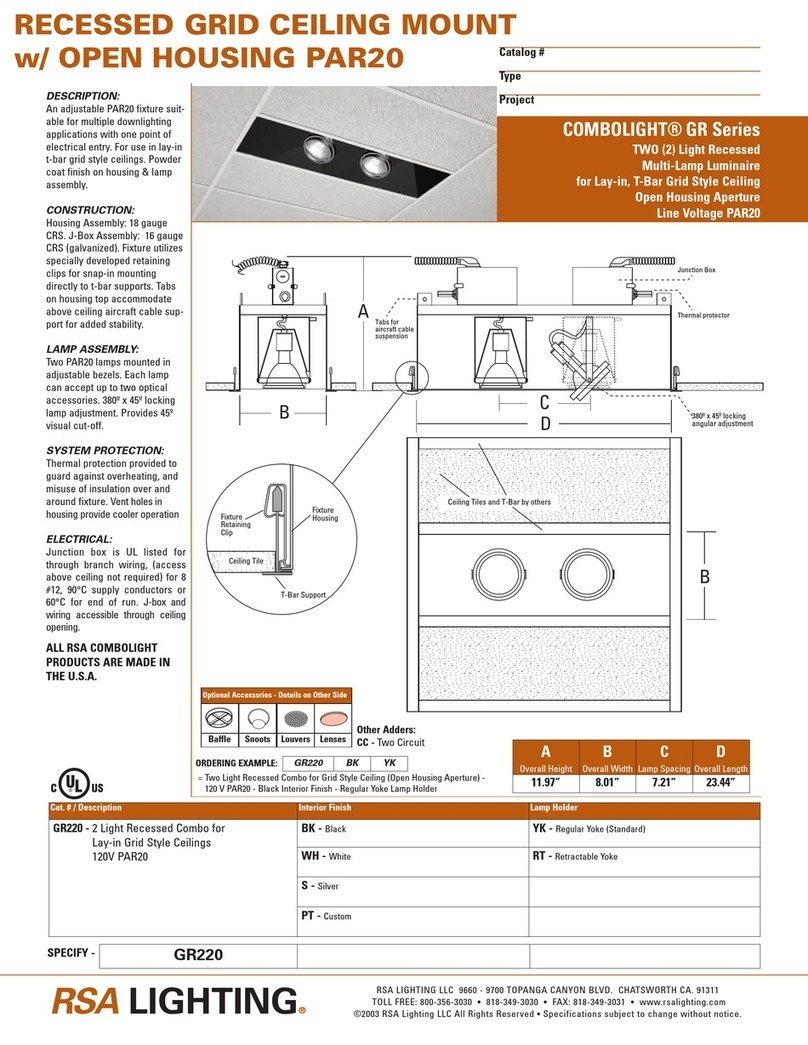Intelight STARLET EXTERNAL LED SO User manual

FAULTY OPERATION AND ITS POSSIBLE DIAGNOSIS
LED indicator does not light u
AC power failure.
LED indicator is red, the luminaire does not o erate (AT or MT version, e.g. in SA / M mode)
Battery pack is damaged or disconnected, damaged light source or electronic circuit.
Red LED indicator lights u or blinks (AT version)
The luminaire performs testing or damage of any part of the luminaire possible. Please, refer to the “TE TING” section.
The luminaire does not o erate in emergency mode the required time for a selected model
It is possible that the battery requires a full charge cycle (48h). If after 48 hours of charging the luminaire still does not keep a
predefined autonomy, it is possible that the battery is run-down or damaged, e.g. due to possible incorrect formatting and needs to
be replaced.
RECOMMENDED PERIODICAL MAINTENANCE
The luminaire should be tested on regular basis in accordance with valid laws and regulations. The results of the tests should be
recorded and stored for the use of a fire safety inspector.
Once a day
It is suggested to check visually if the LED indicator in the luminaire lights up in green.
Once a month
It is necessary to perform a function test (e.g. by disconnecting the AC power supply) and checking whether the luminaire is
operating in emergency mode - the green LED indicator should turn off, and LED light source light up.
Once a year
In order to make an autonomy test (e.g. by disconnect the AC power supply) and check if the luminaire operates in emergency
mode for a specified time. If the autonomy time of emergency operation is not sufficient, the battery needs to be fully recharged
and the test is to be carried out again. If the result of the test continues to be negative, the battery needs to be replaced.
CAUTION!
All damage that might occur as an effect of the device being used not in accordance to this instruction will result in loss of
guarantee.
Used or damaged lamps including batteries, are subject to be recycled. They should be delivered to the point of collection of
electrical and battery waste or to the manufacturer.
The light source contained in this luminaire
shall only be replaced by the manufacturer or
his service agent or a similar qualified person.
Handling of obsolete equi ment
Pursuant to the Act of 29 July 2005 on
waste electrical and electronic
equipment and the Act of 24 April 2009
on batteries and accumulators, the
presented device, after use, due to
hazardous substances contained in it, is
subject to collection of waste electrical
and electronic equipment. Detailed
information on WEEE collection can be
obtained from municipal authorities.
Intelight S . z o.o.
8, Rydygiera str.
01 -793 Warsaw, Poland
KTM 97116 – Instruction Starlet External, P, EN, ver.201 0110
STARLET EXTERNAL LED EMERGENCY LUMINAIRE
Installation and maintenance instructions
Version:
STARLET EXTERNAL LED SO
STARLET EXTERNAL LED SC
OV
TECHNICAL SPECIFICATIONS:
Light
source
*
(
non
-
replaceable
):
White
LED: 3W or 5W
Operating modes
*
:
A
(M)
-
mains and emergency operation
or
A (NM) - emergency operation
Test versions
*
:
MT
–
manual test
or
AT – auto test or
CT – central test
Emergen
cy
autonomy
*
:
1
or
3 hours
Battery
*
(
non
-
replaceable
):
Ni
-
Cd: 1300
-
25
00 lub
Ni
-
MH
:
2000
-
42
00
mAh / 3
,
6V
Battery charging duration:
24
h
Power supply
*
:
MT, AT
and
CT:
220
-
24
0V AC 50Hz
CB (central battery): 220V AC/DC
Max. power
*
:
3
W
-
9
W
Luminous flux*:
3W:
120
-
200
lm; 5W: 2
5
0
-
300
lm
Module:
tarlet External
Enclosure IP rating:
IP
41
Ambient temperature:
10
-
55°C
*
-
depending on model
INTRODUCTION
1. The lamp should be installed when power supply is off. afety rules, construction and electrical installation standards should
be followed all the time.
2. The luminaire should not be powered with circuits connected to inductive power-receiving devices at the same time. This type
of solution may cause damage to the electronic module of the luminaire.
3. The luminaire should be used indoors.

INSTALLATION
1. Before installation one has to make sure that the luminaire will be connected to 220-240VAC power supply by the use of
minimum a 1,5mm2 wire.
2. In order to install the luminaire on a ceiling, first one need to open the luminaire housing by pressing with a screwdriver on
one of the latches on the side of the housing, which fix the luminaire cover to its base. After releasing all the three latches and
decomposing the housing, one need to fix the luminaires’ base containing electronics and a battery pack to the ceiling using
two mounting holes designed for this purpose. A large hole with a grommet is designed to conduct the power cables, one
need to cut a right size hole in the grommet to ensure proper sealing.
3. Prepare power cable and connect all the wires to the appropriate terminal block entries.
4. The description of luminaire terminals:
L - phase wire - brown or black insulation colour; power source for Maintained operation and battery charging, presence
signaled by signal LED lighting up in green
L1 – used for A / M mode jumper (Note: the jumper is being delivered already connected to L1 and L)
N - neutral wire - blue insulation colour
PE - earth wire - yellow and green insulation colour
5. EMERGENCY OPERATION (A, NM). To enable emergency operation of the luminaire the AC mains power has to be connected
to appropriate terminals: L (phase) and N (neutral). Always remember about connecting the protection earth wire (PE).
Additionally, one need to remove the jumper which connects the L and L1 terminals, L1 terminal should remain not
connected. The luminaire should be constantly supplied by power - voltage drop on L will result in emergency mode
activation.
6. MAINS AND EMERGENCY OPERATION (SA, M). For the mains and emergency mode of the luminaire, the AC mains supply
needs to be connected to appropriate terminals: L (phase) and N (neutral). Always remember about connecting the protection
earth wire (PE). In addition, the pre-installed between L and L1 terminals jumper must remain in place (if there is no jumper, it
must be installed). Phase loss on L will cause automatic activation of the emergency mode.
7. Before connecting the luminaire to the mains network, insert the white battery plug into the socket on the PCB.
8. Please remember to indicate the date of installation on the label attached to the battery pack.
9. In order to finish the installation, one need to click the housing cover into the luminaire’s body.
10. For quick operation testing – switch on the AC power supply. The green LED indicator should light up, signaling the mains
connection and battery charging. After battery is charged, the LED indicator should still light up in green, what means
readiness for emergency operation. By pressing the test button, one can check if the luminaire enters the emergency
operation when the power supply is off. The way how to press the test button and how to read the luminaire’s behaviour
depends on its version. You can find detailed information in the “TE TING” section.
11. First-time charge of the luminaire battery pack should be carried out continuously for 48 hours. This will allow appropriate
formatting of the battery pack. During the first-time charge, no testing should be carried out and power supply should not be
disconnected for any other purpose. Power supply should be disconnected after 48 hours for the first time. The luminaire
should complete a full emergency operation cycle, after which it should be connected to power supply for another 36 hours.
This sequence shall complete the formatting cycle.
OPERATION
Emergency o eration mode
In this mode (A, NM) the luminaire does not light when powered by AC supply voltage. Correct operation of the device is confirmed
by LED indicator lighting up in green. The battery is being continuously trickle charged for the purpose of a possible emergency
operation. When AC power supply is off (no voltage on L), the luminaire automatically starts operating in emergency mode and the
source of light is activated for the period specific for a particular model. During emergency operation, the LED indicator is off.
Mains and emergency o eration mode
In this mode ( A, M) the luminaire lights up when powered by AC supply voltage. Correct operation of the device is also confirmed
by LED indicator lighting up in green. The battery is being continuously trickle charged for the purpose of possible emergency
operation. When AC power supply is off (no voltage on L), the luminaire automatically starts operating in emergency mode and the
source of light is activated for the period specific for a particular model. During emergency operation, the LED indicator is off.
Information on lam o eration
The luminaire operates correctly and charging circuit works if the LED indicator lights up in green. If the indicator does not light up,
the lamp is not operating with AC power supply on or any luminaire’s element (e.g. the battery) has been damaged. ee more info
about signaling in “TE TING” section.
Battery ack
The luminaire is equipped with a rechargeable Ni-Cd or Ni-MH battery pack. Please remember to carry out the correct first-time
charge cycle (see “IN TALLATION”, p.11). After such a formatting cycle it achieves its capacity and is prepared to perform a possible
full time emergency operation. It is suggested to discharge and then to re-charge the battery every three months, even if it hasn’t
been used, in order to extend its performance. It is recommended to replace the battery once every four years of operation or in a
case of poor test results. Obsolete batteries, similarly to packaging, fluorescent lamps or electronics, are recyclable products that
should be disposed to a recyclable waste collection point.
TESTING
TARLET EXTERNAL LED luminaire is equipped with a TE T button, which is being used both for MT – manual test versions and AT –
auto test versions. It enables to test emergency operation of the luminaire.
AT auto test function
If a luminaire version has an auto test functionality, the TE T button is being used to initiate and break either function or autonomy
tests. When the luminaire is connected to mains network and there is no voltage drop, pressing and holding the test button,
depending on time of pressing, will result in activation of any of the two. Pressing the button for more than 2s and not longer than
5s (2s<t<5s) initiate the function test, for more than 5s and not longer than 10s (5s<t<10s) – initiate the autonomy test, while for
t>10s – breaks any currently running test. For a convenient counting of nr. of seconds – when a test button is pressed and hold –
after every second the luminaire confirms the passing time by a quick flash of a red indication LED.
In a standard luminaire operation, both functional and autonomy tests are being initialised automatically, function test every 28
days and autonomy test every 336 days. There is no possibility to break any automatically planned test. There is also no possibility
to erase any test results, this means that any signalled failures can be cancelled only after making the luminaire repaired and
further re-testing it with a positive result.
All the possible luminaire working states and LED indications are gathered in the table below.
Legend:
T – 1s period; T2 – 10s period; t – time of pressing the test button
FLA HING: (1/T) / (2/T) – 1 flash / 2 flashes every 1s period
FLA HING: (1/T2) / (2/T2) – 1 flash / 2 flashes every 10s period
(*): test duration is same as an autonomy time declared for a given luminaire
MT manual test function
When the emergency luminaire is connected to mains and there is no voltage drop, pressing and holding TE T button will result in
activation of the “voltage drop” mode, the signal LED will go off and the luminaire should light up. When the button is released -
the luminaire will switch back into its standard operation mode.
The above action means that in a case of emergency mode version the luminaire will go from unlit to illuminated. In a case of mains
and emergency mode the luminaire will change a power source, from mains to a battery supply, the switch-over moment should be
visible as a quick blink – during a very short while the light source will be off.
CAUTION! In a case of A (M) luminaire version, but wired as A (NM) one, the lamp behaves according to A (NM) typical behaviour.
CT (central test) and CB (central battery) versions
Note – CB version may be equipped in manual test button, however it is inactive in this luminaire’s version. Pressing the button will
not result in any luminaire’s reaction.
CT version is being programmed individually according to a particular model of a central controller, depending on customer’s
requirements and installation needs. Communication is being carried through R 485 port.
CB version is being monitored directly by a central battery controller, depending on functionalities and settings of a particular
system.
This manual suits for next models
1
Other Intelight Light Fixture manuals
Popular Light Fixture manuals by other brands
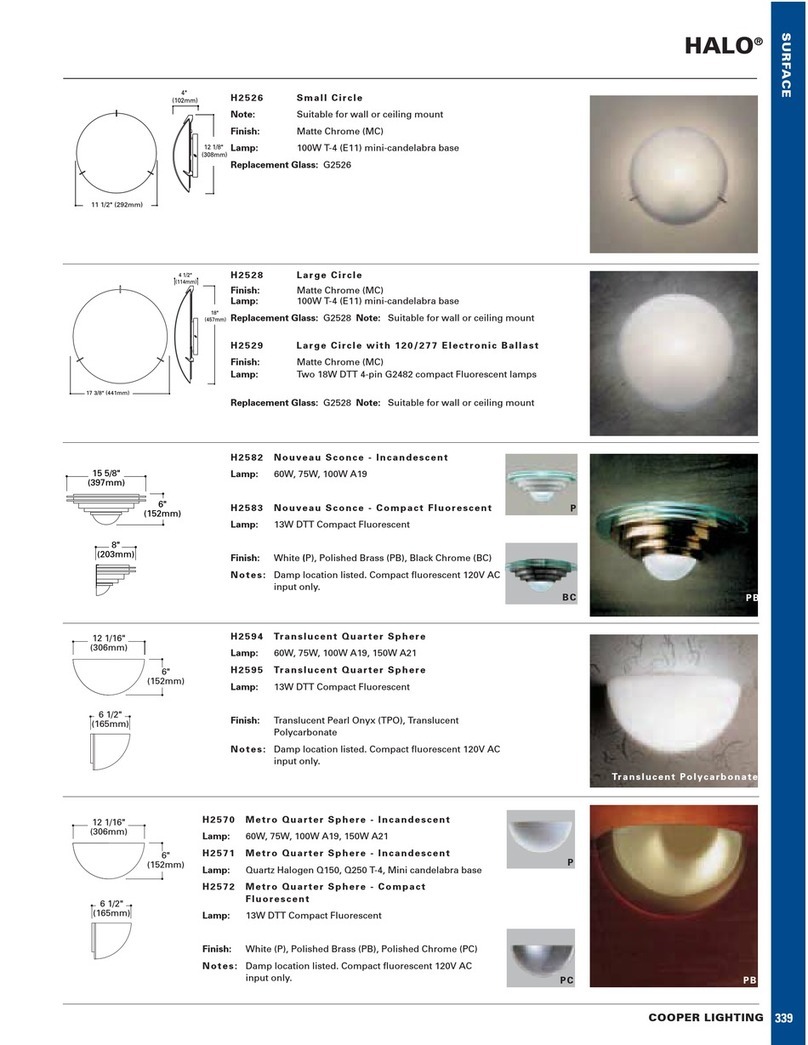
Cooper Lighting
Cooper Lighting HALO H2570 Specification sheet
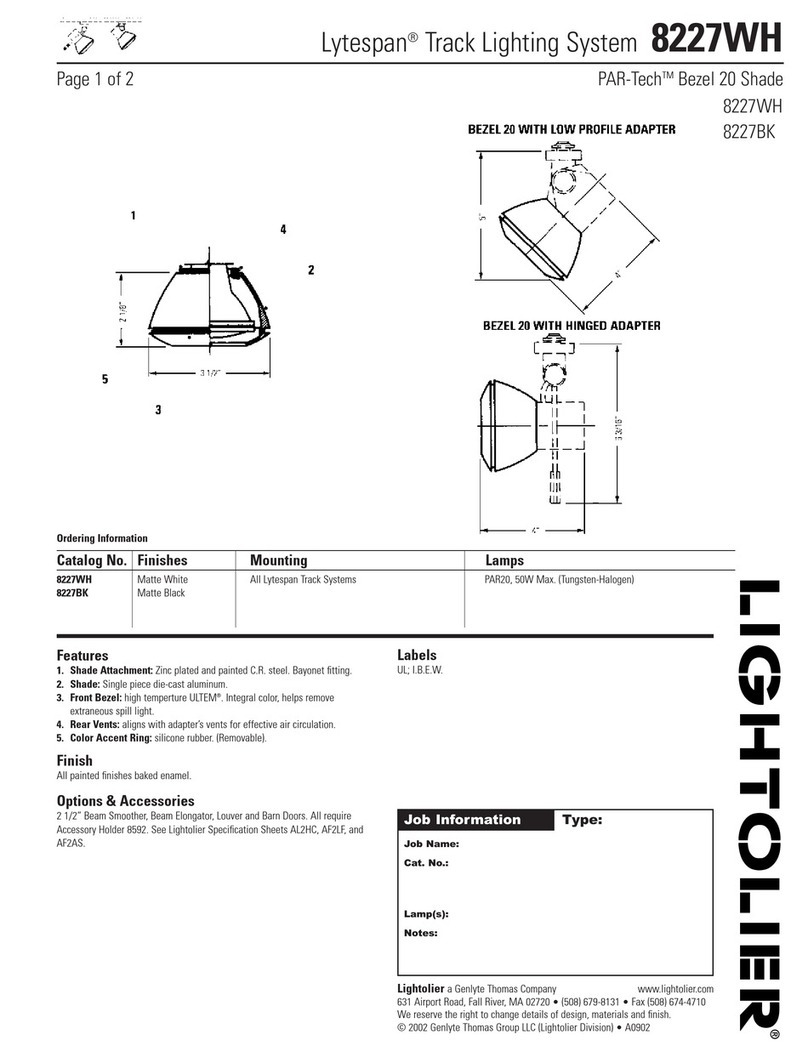
Lightolier
Lightolier Lytespan 8227WH specification

ViSAGE
ViSAGE VIS0481 operating instructions
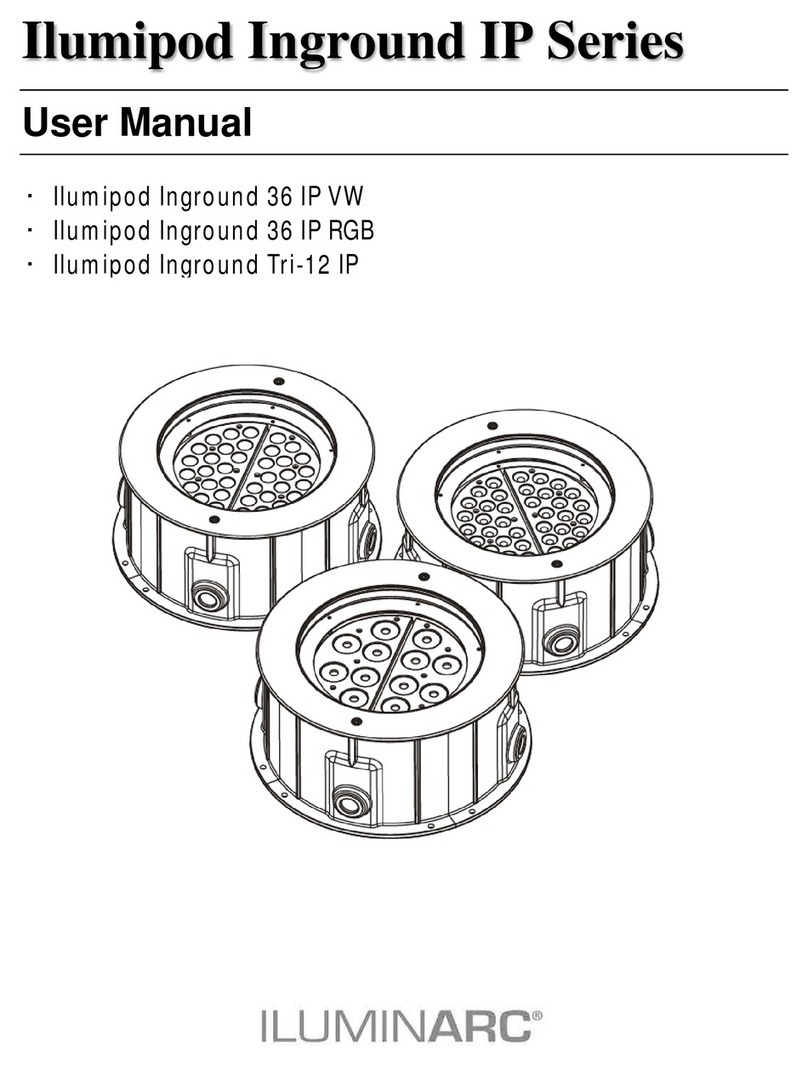
Iluminarc
Iluminarc Ilumipod Inground 36 IP VW user manual

L&L
L&L NEVA 5.0 installation instructions
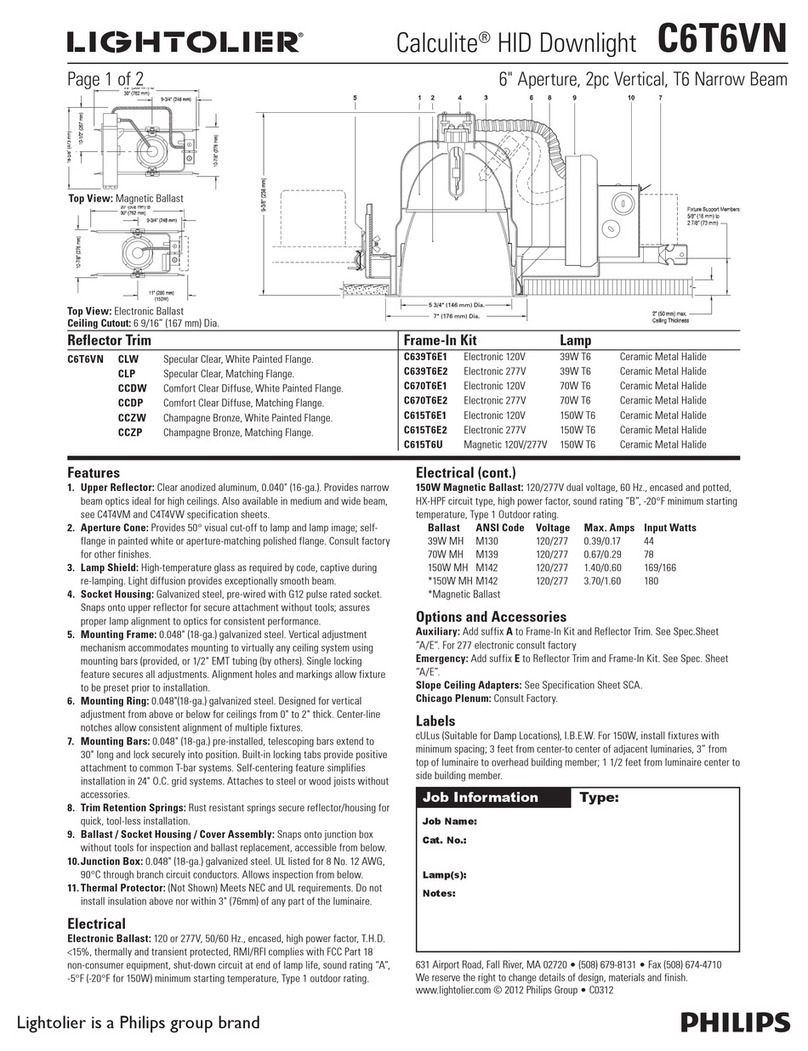
Lightolier
Lightolier Calculite C6T6VN specification
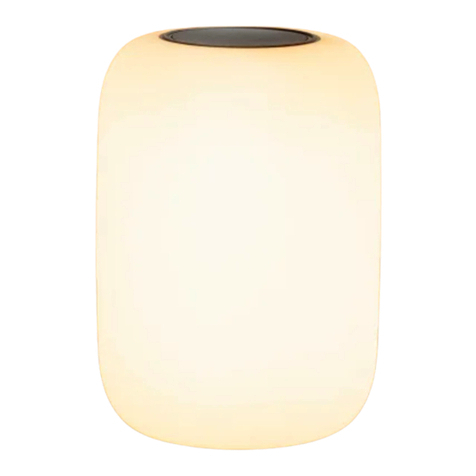
Casper
Casper Glow manual
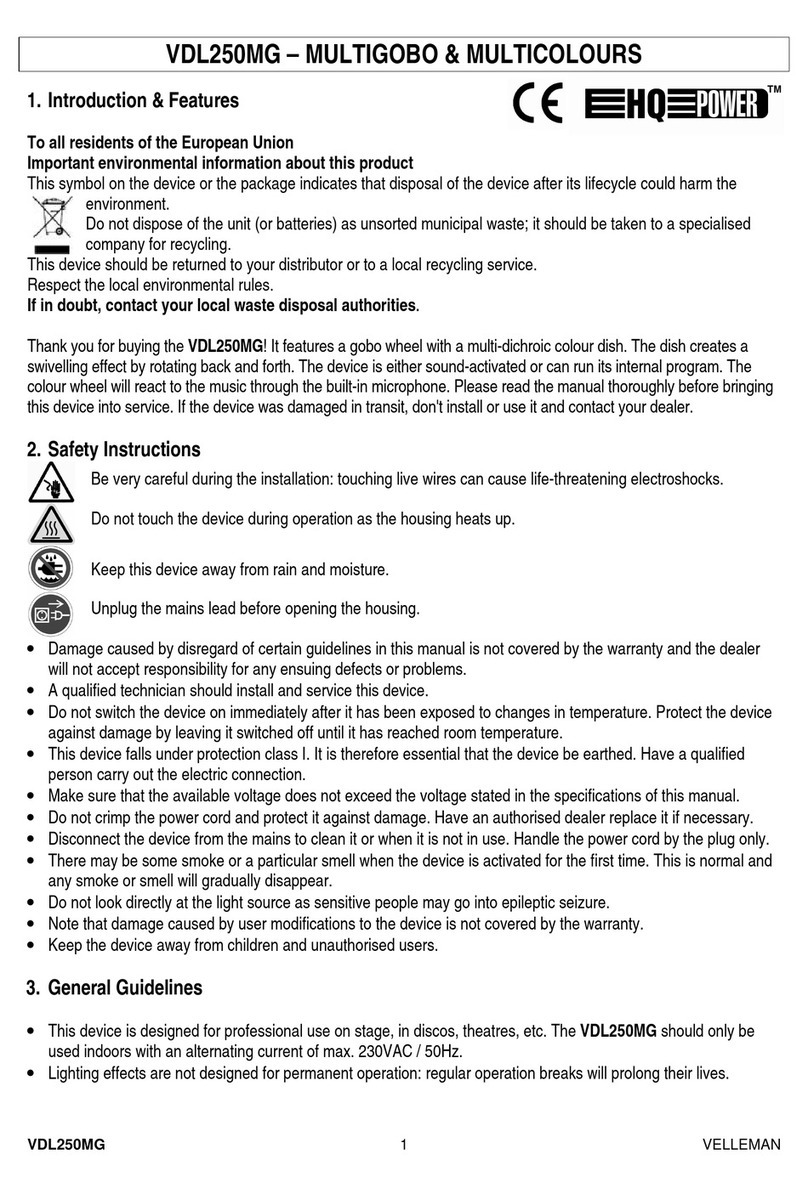
Velleman
Velleman VDL250MG manual
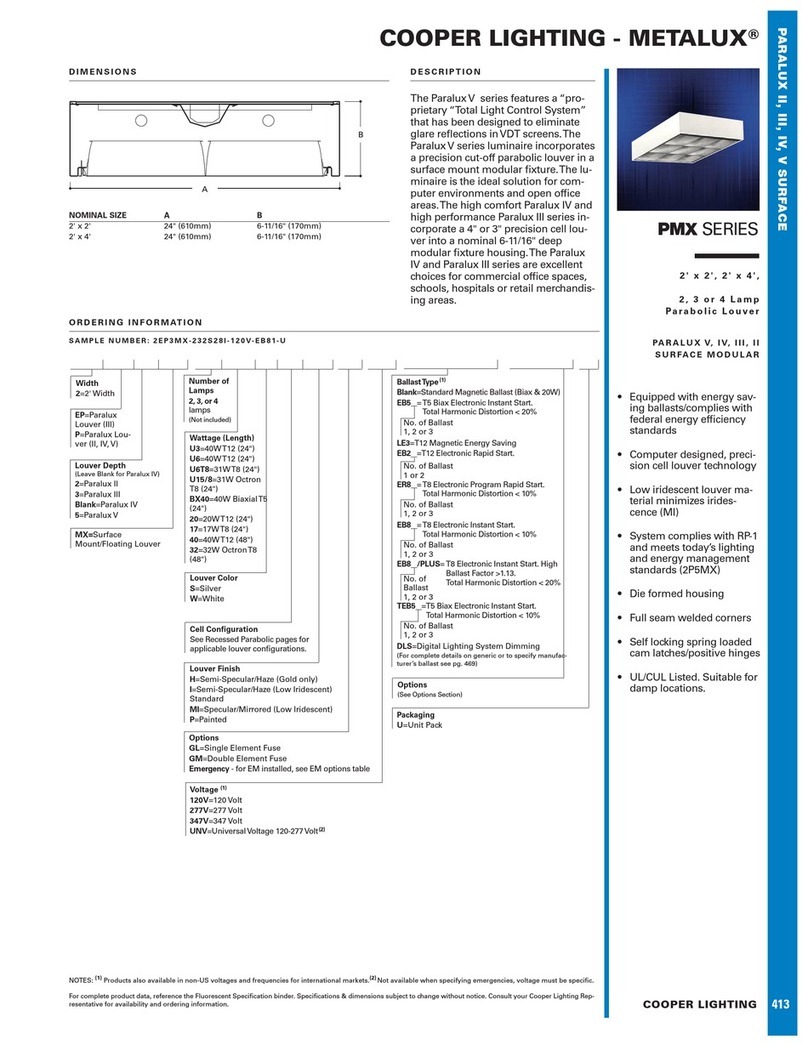
Cooper Lighting
Cooper Lighting Metalux PMX Series Specifications
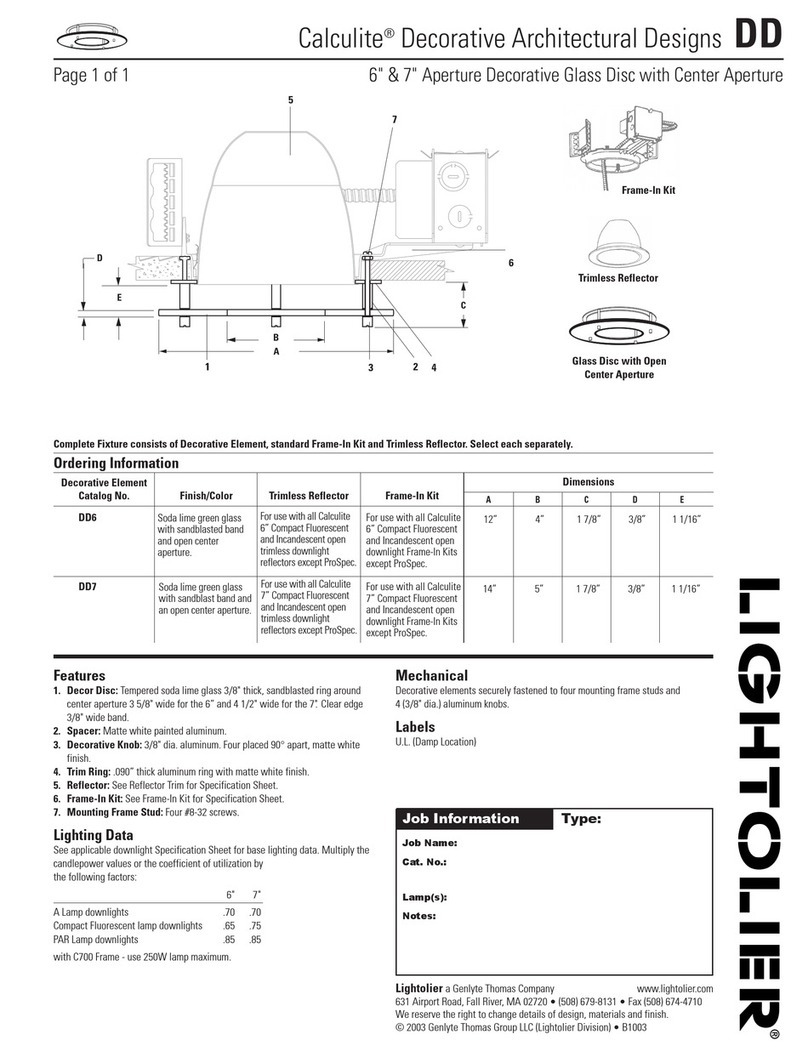
Lightolier
Lightolier Calculite DD specification

American DJ
American DJ Vizi Wash LED 108 User instructions
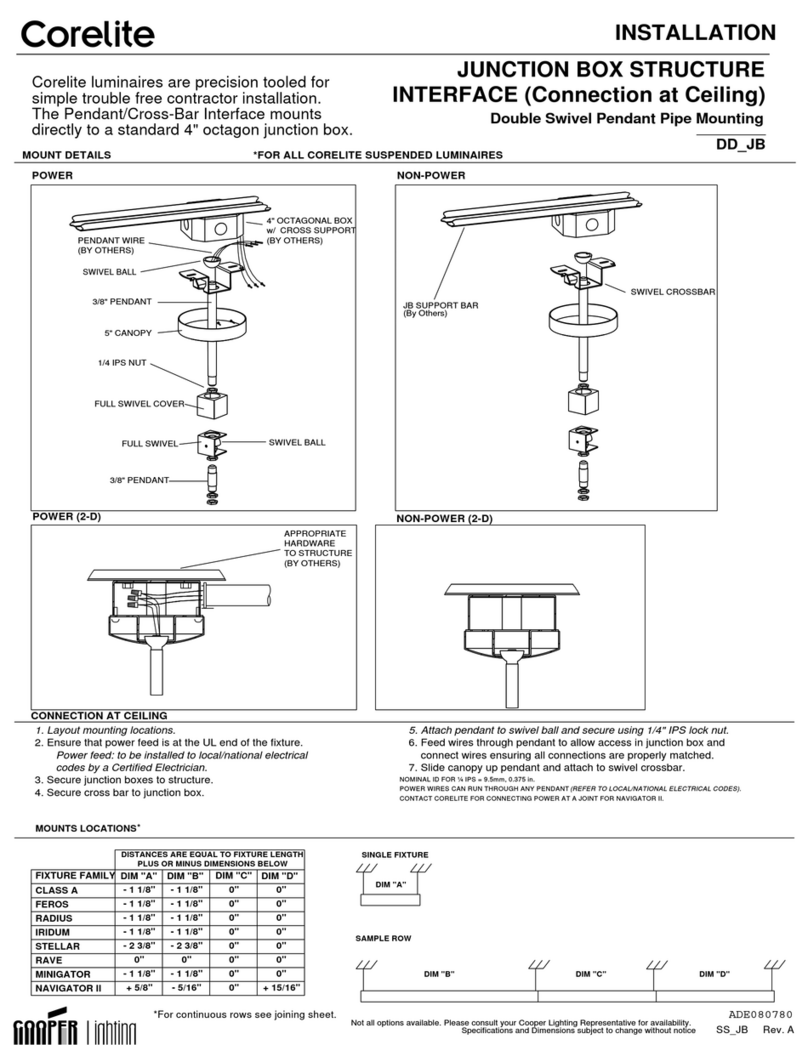
Cooper Lighting
Cooper Lighting Corelite Junction Box Structure Interface installation guide
